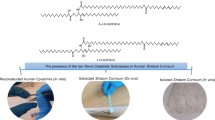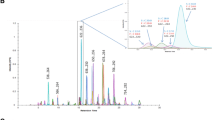Abstract
The barrier function of the stratum corneum (SC) is directly related to: (1) the nature and the composition of the lipids in the intercellular spaces and (2) the conformational order of the ceramides within this layer. The aim of this work was to determine Raman descriptors for the lateral packing, the conformation, and the structure of ceramides III, IIIA, and IIIB issued from the same phytosphingosine ceramide and only presenting differences in the number of double bonds in the hydrocarbon chains. Temperature was used as a variable parameter in order to access the different states of the conformational order and supramolecular organization of the three ceramides, and Raman spectra were collected at each temperature. By using a high-resolution Raman spectrometer and working on a spectral range going from 400 to 3,200 cm−1, we were able to assess simultaneously the different descriptors of structure and organization, i.e., the methyl rocking bands (840–910 cm−1) for the chain-end conformers, the C–C skeletal stretching (1,060–1,130 cm−1), and the CH stretching region (2,800–3,050 cm−1) for the trans and gauche conformations, the CH2 scissoring bands to follow the changes in the lateral packing, and finally the amide I band to evaluate the state of the H-bonds between the polar and head groups.
















Similar content being viewed by others
References
Elias PM (2005) Interactions among stratum corneum defensive functions. J Invest Dermatol 125:183–200
Wertz PW (1996) The nature of the epidermal barrier: biochemical aspects. Adv Drug Deliv Rev 18:283–294
Wertz PW, van den Bergh B (1998) The physical, chemical and functional properties of lipids in the skin and other biological barriers. Chem Phys Lipids 91(2):85–96
Jungersted JM et al (2008) Lipids and skin barrier function—a clinical perspective. Contact Dermat 58(5):255–262
Stewart ME, Downing DT (1999) A new 6-hydroxy-4-sphingenine-containing ceramide in human skin. J Lipid Res 40(8):1434–1439
Wertz PW et al (1987) Essential fatty acids and epidermal integrity. Arch Dermatol 123(10):1381–1384
Wertz PW et al (1987) Composition and morphology of epidermal cyst lipids. J Invest Dermatol 89(4):419–425
Raudenkolb S et al (2003) Polymorphism of ceramide 3. Part 1: an investigation focused on the head group of N-octadecanoyl phytosphingosine. Chem Phys Lipids 123(1):9–17
Raudenkolb S, Wartewig S, Neubert RH (2003) Polymorphism of ceramide 3. Part 2: a vibrational spectroscopic and X-ray powder diffraction investigation of N-octadecanoyl phytosphingosine and the analogous specifically deuterated d(35) derivative. Chem Phys Lipids 124(2):89–101
Gniadecka M et al (1998) Structure of water, proteins, and lipids in intact human skin, hair, and nail. J Invest Dermatol 110:393–398
Goni FM, Alonso A (2006) Biophysics of sphingolipids I membrane properties of sphingosine ceramides and other simple sphingolipids. Biochim Biophys Acta 1758(12):1902–1921
Holtje M et al (2001) Molecular dynamics simulations of stratum corneum lipid models: fatty acids and cholesterol. Biochim Biophys Acta 1511(1):156–167
Onken HD, Moyer CA (1963) The water barrier in human epidermis. Physical and chemical nature. Arch Dermatol 87:584–590
Bouwstra JA, Ponec M (2006) The skin barrier in healthy and diseased state. Biochim Biophys Acta 1758(12):2080–2095
Chen H et al (2000) Fourier transform infrared spectroscopy and differential scanning calorimetry studies of fatty acid homogeneous ceramide 2. Biochim Biophys Acta 1468(1–2):293–303
Moore DJ, Rerek ME, Mendelsohn R (1997) FTIR spectroscopy studies of the conformational order and phase behavior of ceramides. J Phys Chem 101(44):8933–8940
Neubert R et al (1997) Structure of stratum corneum lipids characterized by FT-Raman spectroscopy and DSC II. Mixtures of ceramides and saturated fatty acids. Chem Phys Lipids 89(1):3–14
Wegener M et al (1996) Structure of stratum corneum lipids characterized by FT-Raman spectroscopy and DSC I. Ceramides. Int J Pharm 128:203–213
Bouwstra JA et al (1998) Role of ceramide 1 in the molecular organization of the stratum corneum lipids. J Lipid Res 39(1):186–196
Wegener M et al (1997) Structure of stratum corneum lipids characterized by FT-Raman spectroscopy and DSC III. Mixtures of ceramides and cholesterol. Chem Phys Lipids 88(1):73–82
Raudenkolb S, Wartewig S, Neubert RH (2005) Polymorphism of ceramide 6: a vibrational spectroscopic and X-ray powder diffraction investigation of the diastereomers of N-(alpha-hydroxyoctadecanoyl)-phytosphingosine. Chem Phys Lipids 133(1):89–102
Garidel P (2005) Structural organisation and phase behaviour of a stratum corneum lipid analogue: ceramide 3A. ChemPhysChem 8(19):2265–2275
Lambers H et al (1999) Ceramides. C.R. 1 (ed)
Product data sheet of ceramide III IIIB, D G P C A, reference B 04/02
Product data sheet of ceramide IIIA, D G P C A, reference B 03/01
Caussin J et al (2008) Lipid organization in human and porcine stratum corneum differs widely, while lipid mixtures with porcine ceramides model human stratum corneum lipid organization very closely. Biochim Biophys Acta 1778(6):1472–1482
Gaber BP, Peticolas WL (1977) On the quantitative interpretation of biomembrane structure by Raman spectroscopy. Biochim Biophys Acta 465(2):260–274
Gaber BP, Yager P, Peticolas WL (1978) Interpretation of biomembrane structure by Raman difference spectroscopy. Nature of the endothermic transitions in phosphatidylcholines. Biophys J 21(2):161–176
Bouwstra JA et al (1996) Phase behavior of isolated skin lipids. J Lipid Res 37(5):999–1011
Bouwstra JA et al (2002) Phase behavior of stratum corneum lipid mixtures based on human ceramides: the role of natural and synthetic ceramide 1. J Invest Dermatol 118(4):606–617
Caussin J, Gooris GS, Bouwstra JA (2008) FTIR studies show lipophilic moisturizers to interact with stratum corneum lipids, rendering the more densely packed. Biochim Biophys Acta 1778(6):1517–1524
Lafleur M (1998) Phase behaviour of model stratum corneum lipid mixtures: an infrared spectroscopy investigation. Can J Chem 76(11):1501–1511
Laugel C, Yagoubi N, Baillet A (2005) ATR-FTIR spectroscopy: a chemometric approach for studying the lipid organisation of the stratum corneum. Chem Phys Lipids 135(1):55–68
Mimeault M, Bonenfant D (2002) FTIR spectroscopic analyses of the temperature and pH influences on stratum corneum lipid phase behaviors and interactions. Talanta 56(3):395–405
Rerek ME et al (2005) FTIR spectroscopic studies of lipid dynamics in phytosphingosine ceramide models of the stratum corneum lipid matrix. Chem Phys Lipids 134(1):51–58
Snyder RG, Hsu SL, Krimm S (1978) Vibrational spectra in the C–H stretching region and the structure of the polymethylene chain. Spectrochim Acta 34A:395–406
Snyder RG et al (1996) IR spectroscopic study of the structure and phase behavior of long-chain diacyl phosphatidylcholines in the gel state. Biophys J 71(6):3186–3198
Gaber BP, Yager P, Peticolas WL (1978) Conformational nonequivalence of chains 1 and 2 of dipalmitoyl phosphatidylcholine as observed by Raman spectroscopy. Biophys J 24(3):677–688
Yellin N, Levin IW (1977) Hydrocarbon chain disorder in lipid bilayers. Temperature dependent Raman spectra of 1,2-diacyl phosphatidylcholine-water gels. Biochim Biophys Acta 489(2):177–190
O'Leary TJ, Levin IW (1984) Raman spectroscopic study of an interdigitated lipid bilayer. Dipalmitoylphosphatidylcholine dispersed in glycerol. Biochim Biophys Acta 776(2):185–189
Bunow MR, Levin IW (1980) Molecular conformations of cerebrosides in bilayers determined by Raman spectroscopy. Biophys J 32(3):1007–1021
Csiszar A et al (2006) The phase transition behavior of 1, 2-dipalmitoyl-sn-glycero-3-phosphocholine (DPPC) model membrane influenced by 2, 4-dichlorophenol—an FT-Raman spectroscopy study. Chem Phys Lipids 139(2):115–124
Onogi C, Motoyama M, Hamaguchi H (2008) High concentration trans form unsaturated lipids detected in a HeLa cell by Raman microspectroscopy. J Raman Spectrosc 39(5):555–556
Wartewig S, Neubert RH (2007) Properties of ceramides and their impact on the stratum corneum structure: a review Part 1: ceramides. Skin Pharmacol Physiol 20(5):220–229
Moore DJ, Rerek ME, Mendelsohn R (1997) Lipid domains and orthorhombic phases in model stratum corneum: evidence from Fourier transform infrared spectroscopy studies. Biochem Biophys Res Commun 231(3):797–801
Moore DJ, Rerek ME, Mendelsohn R (1999) Role of ceramides 2 and 5 in the structure of the stratum corneum lipid barrier. Int J Cosmet Sci 21(5):353–368
Sprunt JC, Jayasooriya UA, Wilson RH (2000) A simultaneous FT-Raman-DSC (SRD) study of polymorphism in sn-1,3-distearoyl-2-oleoylglycerol (SOS). ChemPhysChem 2(19):4299–4305
Wartewig S et al (1998) Structure of stratum corneum lipids characterized by FT-Raman spectroscopy and DSC IV. Mixtures of ceramides and oleic acid. Chem Phys Lipids 91:145–152
Lawson EE et al (1998) Thermally induced molecular disorder in human stratum corneum lipids compared with a model phospholipid system; FT-Raman spectroscopy. Spectrochim Acta A Mol Biomol Spectrosc 54A(3):543–558
Koningsten JA (1971) In: Koningsten JA (ed) Introduction of the theory of the Raman effect. D. Reidel, Dordrecht
Gobinet C et al (2005) Independent component analysis and Raman spectroscopy on paraffinised non dewaxed cutaneous biopsies: a promising methodology for melanoma early diagnosis. In: International Workshop on Biosignal Processing and Classification BPC. Barcelona, Spain
Gobinet C et al (2005) A method of digital deparaffining based on Raman spectroscopy and independent component analysis: application to melanoma early diagnosis. In: European Medical & Biological Engineering Conference EMBEC 05. Prague, Czech Republic
Pare C, Lafleur M (1998) Polymorphism of POPE/cholesterol system: a 2H nuclear magnetic resonance and infrared spectroscopic investigation. Biophys J 74(2 Pt 1):899–909
Percot A, Lafleur M (2001) Direct observation of domains in model stratum corneum lipid mixtures by Raman microspectroscopy. Biophys J 81(4):2144–2153
Acknowledgment
The authors wish to thank Dr. Olivier PIOT and Dr. Johanna SAUNIER for their contribution in this work and Pr. Najet YAGOUBI for the IR and DSC instrumentations.
Author information
Authors and Affiliations
Corresponding author
Rights and permissions
About this article
Cite this article
Tfayli, A., Guillard, E., Manfait, M. et al. Thermal dependence of Raman descriptors of ceramides. Part I: effect of double bonds in hydrocarbon chains. Anal Bioanal Chem 397, 1281–1296 (2010). https://doi.org/10.1007/s00216-010-3614-y
Received:
Revised:
Accepted:
Published:
Issue Date:
DOI: https://doi.org/10.1007/s00216-010-3614-y




